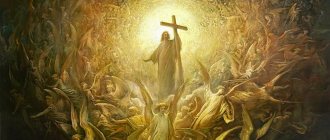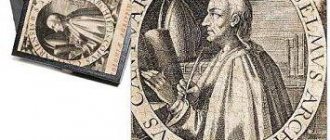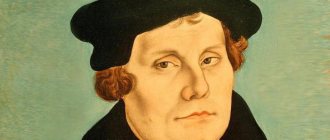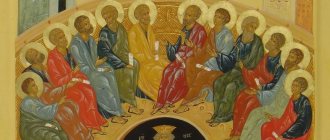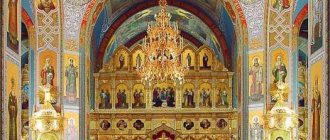PROTESTANTISM, one of the main (along with Orthodoxy and Catholicism) trends in Christianity, which arose in the 16th century. during the Reformation. The origin of the term dates back to the events of 1529, when at the Reichstag of the Holy Roman Empire, held in Germany. Speyer, it was proposed to cancel the decision of the previous Reichstag (1526, also in Speyer) on the right of princes and imperial cities to independently choose their religion on their territory before the convening of an all-German council. Supporters of the Reformation, who did not agree with this proposal and left the meeting, having previously drawn up the so-called. The Speyer protest (from the Latin protestatio - proclamation) began to be called Protestants. Subsequently, the term began to be applied to all adherents of the teachings that emerged as a result of the Reformation.
P., having arisen as a collection of various. movements, never represented, unlike Catholicism and Orthodoxy, a single whole. The largest movements of P. include Lutheranism, Calvinism, and Anglicanism (see Anglican Church), which are usually called “classical” P. They are associated with other independent principles. denominations that differ from each other in dogma, cult and organization: Baptists (see Baptistism), Mennonites, Methodists, Adventists (see Adventism), Pentecostals, Quakers, New Apostolic Church, etc. Jehovah's Witnesses, The Church of Jesus Christ of Latter-day Saints (Mormons ), the Christian Science Society and other denominations that are genetically related to Christianity, but in their ideological development have gone far beyond its framework (as well as Christianity in general), are usually classified as new religious movements.
The Birth of Protestantism
The emergence of the Reformation in Europe occurred as a result of dissatisfaction among believers with the immoral behavior and abuse of their rights by many religious figures of the Catholic Church. All these problems were condemned not only by ordinary pious people, but also by public figures and theologians.
The ideas of Protestantism and the Reformation were proclaimed by professors at Oxford and the University of Prague J. Wycliffe and Jan Hus, who opposed the abuse of the rights of priests and the exactions of the Pope imposed on England. They expressed doubts about the right of churchmen to forgive sins, rejected the idea of the reality of the sacrament of communion, of the transformation of bread into the body of the Lord.
Jan Hus demanded that the church give up accumulated wealth, sell positions, and advocated depriving the clergy of various privileges, including the rite of communion with wine. For his ideas, he was declared a heretic and burned at the stake in 1415. However, his ideas were taken up by his Hussite followers, who continued his struggle and achieved some rights.
Major teachings and figures
The founder of Protestantism, who worked first in Germany and Switzerland, was Martin Luther (1483-1546). There were other leaders: T. Münzer, J. Calvin, W. Zwingli. The most pious Catholic believers, having observed for many years the luxury and debauchery occurring among the highest clergy, began to express protests, criticizing them for their formal attitude towards the norms of religious life.
According to the founders of Protestantism, the most striking expression of the church's desire to enrich itself were indulgences, which were sold for money to ordinary believers. The main slogan of the Protestants was the restoration of the traditions of the early Christian church and the increase in the authority of the Holy Scriptures (the Bible), the institution of church power and the existence of priests and the Pope himself as a mediator between the flock and God were rejected. This is how the first direction of Protestantism appeared - Lutheranism, proclaimed by Martin Luther.
Definition and basic postulates
Protestantism is a term derived from the Latin protestatio (proclamation, assurance, dissent), which refers to the body of denominations of Christianity that emerged as a result of the Reformation. The doctrine is based on attempts to understand the Bible and Christ, different from the classical Christian one.
Protestantism is a complex religious formation and includes many directions, the main of which are Lutheranism, Calvinism, Anglicanism, named after scientists who proclaimed new ideas.
The classical teachings of Protestantism contain 5 main postulates:
- The Bible is the only source of religious teaching, which every believer can interpret in his own way.
- All actions are justified by faith alone, regardless of whether they are good or not.
- Salvation is a good gift from God to man, therefore the believer himself cannot save himself.
- Protestants deny the influence of the Mother of God and the saints in salvation and see it only through the sole faith in Christ. Church ministers cannot be mediators between God and the flock.
- Man honors and glorifies only God.
Different branches of Protestantism have differences in their denials of Catholic dogmas and the basic tenets of their religion, the recognition of certain sacraments, etc.
Methodology
For the purposes of this list, the following Christian branches are considered Protestant:
Evangelicals, charismatics, neo-charismatics and other revivalists can be found in virtually all Protestant branches. Also taken into account are non-denominationals, various independents, and Protestants from other denominations who do not fit easily into the traditional classification.
Estimates of the general Protestant population vary considerably. The most reliable sources claim a range from 800 million to more than 1 billion. Difficulties arise because there is no consensus among scholars about which denominations should be considered Protestant.
Lutheran (Evangelical) Church
The beginning of this direction of Protestantism was laid by the teachings of M. Luther and his translation of the Bible from Latin into German, so that every believer could get acquainted with the text and have their own opinion and interpretation of it. The new religious teaching put forward the idea of subordinating the church to the state, which aroused interest and popularity among the German kings. They supported the reforms, dissatisfied with large payments of money to the Pope and his attempts to interfere in the politics of European states.
Lutherans in their faith recognize 6 books written by M. Luther “Augsburg Confession”, “Book of Concord”, etc., which set out the basic dogmas and ideas about sin and its justification, about God, the Church and the sacraments.
It became widespread in Germany, Austria, Scandinavian countries, and later in the USA. Its main principle is “justification by faith”; of the religious sacraments, only baptism and communion are recognized. The Bible is considered the only indicator of the correctness of faith. Priests are pastors who preach the Christian faith, but do not rise above the rest of the parishioners. Lutherans also practice the rites of confirmation, wedding, funeral service and ordination.
Currently, there are about 80 million people and 200 active churches in the world of adherents of the Anglican Church.
Liturgical practice
Worship usually consists of the singing of hymns, congregational prayer, reading of Scripture, and a sermon. The style of worship depends both on the tradition of the confession and on the attitudes of the department. communities
Lutherans, Anglicans, Presbyterians, Mennonites, Methodists recognize different. forms of water baptism: in practice, pouring is more often used, methodologists use sprinkling; in Baptistism, Evangelical Christianity, Adventism, Pentecostalism, and the New Apostolic Church, baptism is performed exclusively by complete immersion. Anglicans, Lutherans, Presbyterians, Congregationalists, Reformed, Methodists, the New Apostolic Church practice baptism of children, Baptists, Adventists, Pentecostals recognize baptism only for adults (usually at 12–18 years of age, among the Hutterites at 20–30 years of age). Children are usually blessed by the pastor at birth, attend worship services, but are not considered members of the Church. In some Protestant denominations, confirmation exists as a rite (in the Anglican Church it is performed by a bishop).
Among the Amish and Dunkers, as well as in a number of Baptist, Adventist and Pentecostal churches. Before the breaking of bread, communities perform the ritual of washing their feet as an element of the Last Supper. Funeral rites are accepted in most Protestant denominations (see Art. Burial), but there are no prayers for the deceased.
Protestants, with the exception of Quakers and Seventh-day Adventists, celebrate the Nativity of Christ, the Epiphany, Easter and Pentecost. The Anglicans have preserved almost all Catholic holidays. Churches, including days of veneration of saints, among Lutherans - 1st Sunday of Advent, Maundy Thursday, Good Friday, All Saints' Day, All Souls' Day. Baptists celebrate the Feast of Harvest (September–October).
Calvinism
Germany was and remains the cradle of the reform movement, but later another movement appeared in Switzerland, which divided into independent groups under the general name of the Churches of the Reformation.
One of the currents of Protestantism - Calvinism, which includes the Reformed and Presbyterian churches, differs from Lutheranism in the greater rigidity of its views and gloomy consistency, which were characteristic of the religious Middle Ages.
Differences from other Protestant movements:
- The Holy Scripture is recognized as the only source, any church councils are considered unnecessary;
- monasticism is denied, because God created women and men for the purpose of forming a family and having children;
- the institution of rituals is being eliminated, including music, candles, icons and paintings in the church;
- the concept of predestination is put forward, the sovereignty of God and his power over the lives of people and the world, the possibility of his condemnation or salvation.
Today, Reformed churches are located in England, many European countries and the USA. In 1875, the “World Alliance of Reformed Churches” was created, which united 40 million believers.
Countries
The seven regions considered in the following table are the six traditional ones (Europe, Asia, Africa, North America, South America, Oceania), as well as the Middle East (i.e., Islamic-majority countries from the Mediterranean to Iran).
Protestants by country
| Region | A country | Total population (year) | % Protestant | Protestant total |
| Asia | Afghanistan (details) | 29 928 987 | 0,03% | 10 000 |
| Europe | Albania (more details) | 3 563 112 | 0,23% | 8 191 |
| Africa | Algeria (details) | 35 531 853 | 1,62% | 250 000 |
| Europe | Andorra (more details) | 71 201 | 2,1% | 1,495 |
| Africa | Angola (details) | 19 600 000 | 30,6% | 5 997 600 |
| North America | Antigua and Barbuda (details) | 68 722 | 68% | 59 101 |
| South America | Argentina (details) | 40 500 000 | 9% | 3 645 000 |
| Europe | Armenia (details) | 2 982 904 | 3,7% | 110 368 |
| Oceania | Australia (details) | 23 401 892 (2016) | 23,1% | 6 355 952 |
| Europe | Austria (details) | 8 823 053 (2017) | 3,4% | 297 578 |
| Europe | Azerbaijan (details) | 8 581 400 | 0,07% | 6 007 |
| North America | Bahamas (details) | 353 658 | 70% | 247 561 |
| Asia | Bahrain (more details) | 688 345 | ? | ? |
| Asia | Bangladesh (more details) | 144 319 628 | 0,23% | 331 935 |
| North America | Barbados (more details) | 278 289 | 67% | 186 454 |
| Europe | Belarus (details) | 10 300 483 | 5% | 515 024 |
| Europe | Belgium (details) | 10 364 388 | 1,35% | 140 000 |
| North America | Belize (details) | 279 457 | 30% | 83 837 |
| Africa | Benin (details) | 9 100 000 | 23% | 2 093 000 |
| Asia | Butane (details) | 2,232,291 | 0,018% | 400 |
| South America | Bolivia (details) | 8 857 870 | 16% -17,2% -20% | 1,417,259 |
| Europe | Bosnia and Herzegovina (details) | 4 025 476 | 0,04% | 1,610 |
| Africa | Botswana (details) | 2 000 000 | 66% | 1,320,000 |
| South America | Brazil (details) | 192 755 799 (2010) — 211 189 413 (2020) | 22,2% -26% | 42,791,786- |
| Asia | Brunei (more details) | 372 361 | 1,3% | 4841 |
| Europe | Bulgaria (details) | 7 450 349 | 1% | 74 503 |
| Africa | Burkina Faso (more details) | 17 000 000 | 9% | 1 360 000 |
| Africa | Burundi (details) | 10 200 000 | 20% | 2 400 000 |
| Asia | Cambodia (more details) | 13 607 069 | 0,04% | 5,390 |
| Africa | Cameroon (details) | 16 380 005 | 20% | 3 276 001 |
| North America | Canada (details) | 37 242 571 | 26% | 8 330 000 |
| Africa | Cape Verde (details) | 415 294 | 3,5% | 14 535 |
| Africa | Central African Republic (details) | 5 000 000 | 61% | 3 050 000 |
| Africa | Chad (details) | 11 500 000 | 18% | 2 070 000 |
| South America | Chile (more details) | 18 192 000 | 13% — 15,5% 11% | 2 365 000 — 2 821 000 |
| Asia | China (details) | 1,382,710,000 (2016) | 2,9% | 39 970 000 |
| South America | Colombia (details) | 46,900,000 (2011) | 12,5% | 5 862 500 |
| Africa | Comoros (more details) | 671 247 | 0,25% | 1,678 |
| Africa | Republic of the Congo (more details) | 4 100 000 | 51% | 2 091 000 |
| Africa | Congo, Democratic Republic (details) | 65 966 000 (2010) | 48% | 31 663 680 |
| North America | Costa Rica (more details) | 4,700,000 (2011) | 12,3% -25% | 1 250 000 |
| Europe | Croatia (details) | 4 495 904 | 2% | 89 918 |
| North America | Cuba (details) | 11 346 670 | 11% | 1 248 133 |
| Europe | Cyprus (details) | 780 133 | 2% | 15 603 |
| Europe | Czech Republic (details) | 10 241 138 | 1,1% | |
| Africa | Ivory Coast (details) | 22 500 000 | 23% | 5 175 000 |
| Europe | Denmark (details) | 5 700 000 | 77% — 82% | 4 389 000–4 674 000 |
| Africa | Djibouti (details) | 900 000 | 0,2% | 1,800 |
| North America | Dominica (more details) | 69 278 | 15% | 10 392 |
| North America | Dominican Republic (details) | 10,000,000 (2011) | 18% (survey) | 1,800,000 |
| Asia | East Timor (details) | 1 040 880 | 1,2% -1,96% | 31 226 |
| South America | Ecuador (details) | 14 700 000 | 12,5% -14% | 1 837 500 |
| Africa | Egypt (details) | 82 600 000 | 1% | 820 600 |
| North America | El Salvador (details) | 6 200 000 | 34,4% / 28% | 2 132 800 |
| Africa | Equatorial Guinea (more details) | 700 000 | 6% | 42 000 |
| Africa | Eritrea (more details) | 5 900 000 | 5% | 295 000 |
| Europe | Estonia (details) | 1 094 564 | 11% | 121 000 |
| Africa | Ethiopia (details) | 73 750 932 (2007) | 18,6% | 13 717 673 |
| Oceania | Fiji (more details) | 893 354 | 42,5% | 379 676 |
| Europe | Finland (details) | 5 534 000 | 68,4% | 3 787 000 |
| Europe | France (details) | 60 656 178 | 2% | 1,213,124 |
| Africa | Gabon (details) | 1 500 000 | 39,7% | |
| Africa | Gambia (more details) | 1,593,256 | 7% | 360 000 |
| Europe | Georgia (details) | 4 677 401 | 2,14% | 100 000 |
| Europe | Germany (details) | 83 167 000 (2019) | 26,0% | 21 610 000 |
| Africa | Ghana (details) | 24 200 000 (2010) | 58,1% | 14 060 200 |
| Europe | Greece (more details) | 10 668 354 | 0,28% | 30 000 |
| North America | Grenada (details) | 89 502 | 30% | 26 851 |
| North America | Guatemala (more details) | 14 700 000 | 38,2% | 6 038 150 |
| Africa | Guinea (details) | 10 200 000 | 4% | 408 000 |
| Africa | Guinea-Bissau (more details) | 1,600,000 | 2% | 32 000 |
| South America | Guyana (more details) | 765 283 | 38% | 290 808 |
| North America | Haiti (details) | 10,100,000 (2011) | 30% | 3 030 000 |
| North America | Honduras (more details) | 6 975 204 | 41% | 2 859 834 |
| Europe | Hungary (details) | 10 006 835 | 14% | 1,401,640 |
| Europe | Iceland (details) | 364 100 (2020) | 70,7% | 257 400 |
| Asia | India (details) | 1 352 642 280 (2018) | Not less than 9,700,000 | |
| Asia | Indonesia (more details) | 270 000 000 (2020) | 7,6% | 20 246 000 |
| Asia | Iran (details) | 68 017 860 | 0,3% | 204 054 |
| Asia | Iraq (details) | 38 146 025 | 0,1% | 40 000 |
| Europe | Ireland (details) | 4,761,900 (2016) | 4,2% | 201 400 |
| Asia | Israel (details) | 6 276 883 | 0,01% | 5,000 (mostly Anglican) |
| Europe | Italy (details) | 58 102 112 | 0,3% -0,6% -0,8% | 755 328 |
| North America | Jamaica (more details) | 2 731 832 | 60% | 1,639,099 |
| Asia | Japan (details) | 127 417 244 | 0,4% | 509 668 |
| Asia | Jordan (details) | 5,759,732 | 0,5% | 28 799 |
| Asia | Kazakhstan (details) | 15 185 844 | 2% | 303 717 |
| Africa | Kenya (details) | 40 513 000 (2010) | 47,4% | 19 203 162 |
| Oceania | Kiribati (more details) | 103 500 | 40% | 41 400 |
| Asia | Korea, North (more details) | 22 912 177 | 0,04% | 10 000 |
| Asia | Korea, South (more details) | 48 422 644 | 18,1% | 8 760 000 |
| Asia | Kuwait (more details) | 2,335,648 | 2,14% | 50 000 |
| Asia | Kyrgyzstan (details) | 5 146 281 | 0,03% | 1,337 |
| Asia | Laos (more details) | 6 217 141 | 0,56% | 35 000 |
| Europe | Latvia (details) | 2 070 371 | 35% | 714 000 |
| Asia | Lebanon (details) | 3 826 018 | 1% | 40 000 |
| Africa | Lesotho (details) | 2 200 000 | 50% | 1 100 000 |
| Africa | Liberia (details) | 4 100 000 | 75% | 3 075 000 |
| Asia | Libya (details) | 6 765 563 | Less than 1% | ? |
| Europe | Liechtenstein (more details) | 33 436 | 7% | 2341 |
| Europe | Lithuania (details) | 3,596,617 | 1% | 35 966 |
| Europe | Luxembourg (more details) | 468 571 | 1% | 4 686 |
| Africa | Madagascar (details) | 21 300 000 | 38% | 8 094 000 |
| Africa | Malawi (more details) | 15 900 000 | 55% | 8 745 000 |
| Asia | Malaysia (more details) | 28 900 000 | 4% | |
| Asia | Maldives (more details) | 349 106 | ||
| Africa | Mali (more details) | 15 400 000 | 1% | 154 000 |
| Oceania | Marshall Islands (more details) | 62 000 | 76,7% | 47 554 |
| Africa | Mauritania (details) | 3 500 000 | 0,1% | 3500 |
| Africa | Mauritius (details) | 1,230,602 | 4,5% | 55 377 |
| North America | Mexico (details) | 114,800,000 (2011) | 5% -10% | 5 700 000–11 400 000 |
| Europe | Moldova (details) | 4 455 421 | 0,26% | 11 634 |
| Oceania | Micronesia (details) | 108 155 | 47% | 50 833 |
| Asia | Mongolia (details) | 2 791 272 | 1,25% | 35 000 |
| Africa | Morocco (more details) | 32 725 847 | Protestant minorities | ? |
| Africa | Mozambique (more details) | 23 100 000 | 27% | 6 237 000 |
| Asia | Myanmar (more details) | 42 909 464 | 3% | 1 287 284 |
| Africa | Namibia (details) | 2 300 000 | 74% | 1 702 000 |
| Oceania | Nauru (details) | 13 048 | 66% | 8 612 |
| Asia | Nepal (details) | 27 676 547 | 0,01 | 3 979 |
| Europe | Netherlands (details) | 16 407 491 | 11% | 3,445,573 |
| Oceania | New Zealand (details) | 4 699 755 | 26,7% | 1,253,742 |
| North America | Nicaragua (details) | 5,900,000 (2011) | 26.5% (PF) | 1 563 500 |
| Africa | Niger (more details) | 16 100 000 | 0,5% | 80 500 |
| Africa | Nigeria (more details) | 200 000 000 | 37,7% | 60 118 563–75 400 000 |
| Europe | North Macedonia (details) | 2 045 262 | 3% | 61 358 |
| Europe | Norway (details) | 5 367 000 | 72,0% | 3 865 000 |
| Asia | Oman (details) | 3 001 583 | N/A | N/A |
| Asia | Pakistan (details) | 162 419 946 | 0,86% | 1,400,000 |
| North America | Panama (details) | 3 600 000 | 24% | 864 000 |
| Oceania | Papua New Guinea (more details) | 5 545 268 | 61,5% | 3 410 340 |
| South America | Paraguay (details) | 6 600 000 | 6% | 396 000 |
| South America | Peru (details) | 29,400,000 (2011) | 12.5% (2006 census) | 3 675 000 |
| Asia | Philippines (more details) | 100 000 000 | 10,0% -8,2% | 10 000 000 |
| Europe | Poland (details) | 38 635 144 | 0,2% | 130 000 |
| Europe | Portugal (details) | 10 566 212 | 0,4% | 348 685 |
| North America | Puerto Rico (details) | 3 500 000 | 15% | 500 000 |
| Asia | Qatar (details) | 863 051 | 1% | Unknown |
| Europe | Romania (more details) | 22 329 977 | 6% | 1,339,799 |
| Asia | Russia (details) | 143 420 309 | 0,29% | 400 000 |
| Africa | Rwanda (details) | 10 900 000 | 43% | 4 687 000 |
| North America | Saint Kitts and Nevis (details) | 38 958 | 74% | 29,335 |
| North America | Saint Lucia (details) | 166 312 | 10% | 16 631 |
| North America | Saint Vincent and the Grenadines (details) | 117 534 | 77% | 90 501 |
| Oceania | Samoa (details) | 179 000 | 49,8% | 89 142 |
| Asia | Saudi Arabia (details) | 26 417 599 | 3,33% | 800 000 |
| Africa | Senegal (details) | 11 126 832 | 0,5% | 55 634 |
| Europe | Serbia (more details) | 7 186 175 | 1,2% | 80 291 |
| Africa | Seychelles (more details) | 81 188 | 8% | 6 495 |
| Africa | Sierra Leone (details) | 5 400 000 | 14% | 756 000 |
| Asia | Singapore (details) | 4 425 720 | 8% | 354 058 |
| Europe | Slovakia (more details) | 5 431 363 | 8.9 | 935 235 |
| Europe | Slovenia (details) | 2 011 070 | 0,8% | 16 135 |
| Africa | Somalia (details) | 9 900 000 | ||
| Africa | South Africa (details) | 50 500 000 (2010) | 72,9% | 36 814 500 |
| Europe | Spain (details) | 50 000 000 | 1% | 500 000 |
| Asia | Sri Lanka (more details) | 20 064 776 | 0,8% | 160 518 |
| Africa | Sudan (details) | 44 600 000 | 5% | 2 200 000 |
| South America | Suriname (details) | 500 000 | 25% | 125 000 |
| Africa | Eswatini (details) | 1 200 000 | 67% | 801 000 |
| Europe | Sweden (details) | 10 000 000 | 60% | 6 000 000 |
| Europe | Switzerland (details) | 8 482 152 (2017) | 27% | 2,290,000 |
| Asia | Syria (details) | 18 448 752 | 0,2% | 37 605 |
| Asia | Taiwan (details) | 22 894 384 | 2,6% | 595 254 |
| Asia | Tajikistan (details) | 7 163 506 | 0,01% | 711 |
| Africa | Tanzania (details) | 62 092 761 | 27% | 16 765 045 |
| Asia | Thailand (details) | 64 076 033 | 0,64% | 407 685 |
| Africa | Togo (details) | 5 681 519 | 9,5% | 539 744 |
| Oceania | Tonga (more details) | 112 422 | 73% | 82 068 |
| North America | Trinidad and Tobago (details) | 1 300 000 | 38% | 494 000 |
| Africa | Tunisia (more details) | 10 074 951 | 3,33% | 335 496 |
| Asia | Türkiye (more details) | 69 660 559 | Less than 1% | 3 000 |
| Asia | Turkmenistan (details) | 4 952 081 | 0,6% | 81 years old |
| Oceania | Tuvalu (details) | 11 636 | 94% | 11 450 |
| Africa | Uganda (details) | 34 856 000 (2014) | 45,1% | 15,720,056 |
| Europe | Ukraine (details) | 47,425,336 | 2,3% | 900 000 |
| Asia | United Arab Emirates (details) | 2,563,212 | 5% | 128 160 |
| Europe | UK (details) | 63 181 775 (2010) | 16% -50% | 10 000 000–32 000 000 |
| North America | USA (more details) | 330 000 000 | 46,5% — 43% — 36% | 118 800 000 — 153 450 000 — 141 900 000 |
| South America | Uruguay (more details) | 3 400 000 | 11% (2006 government survey) | 374 000 |
| Asia | Uzbekistan (more details) | 26 851 195 | 0,01% | 1,345 |
| Oceania | Vanuatu (more details) | 243 304 | 40% | 97 321 |
| Europe | Vatican (details) | 921 | 0% | |
| South America | Venezuela (details) | 33 221 865 | 17% | 5 647 717 |
| Asia | Vietnam (details) | 83 535 576 | 1% | 835 355 |
| Asia | Yemen (details) | 20 727 063 | Approximately 1% | ? |
| Africa | Zambia (details) | 13 500 000 | 68% | 9 180 000 |
| Africa | Zimbabwe (details) | 12 100 000 | 67% | 8 107 000 |
| World | 7 600 000 000 (2017) | 12,1% | 920 000 000 | |
John Calvin and his books
Scientists classify Calvinism as a radical movement in Protestantism. All reform ideas were set forth in the teachings of its founder, who also showed himself as a public figure. Proclaiming his principles, he became practically the ruler of the city of Geneva, introducing his life reforms that corresponded to the norms of Calvinism. His influence in Europe is evidenced by the fact that he earned himself the name “Pope of Geneva.”
The teachings of J. Calvin were set forth in his books “Instructions in the Christian Faith”, “Gallican Confession”, “Geneva Catechism”, “Heidelberg Catechism”, etc. The Reformation of the Church in accordance with Calvin has a rationalistic direction, which is also manifested by distrust of mystical miracles .
Introduction of Protestantism in England
The ideologist of the Reformation movement in the British Isles was Thomas Cranmer, Archbishop of Canterbury. The formation of Anglicanism took place in the 2nd half of the 16th century and was very different from the emergence of Protestantism in Germany and Switzerland.
The Reformation movement in England began at the behest of King Henry VIII, who was denied a divorce from his wife by the Pope. During this period, England was preparing to start a war with France and Spain, which was the political reason for the debunking of Catholicism.
The King of England declared the church national and decided to lead it, subjugating the clergy. In 1534, Parliament announced the introduction of independence of the church from the Pope. All monasteries in the country were closed, their property was transferred to state power to replenish the treasury. However, Catholic rituals were preserved.
Fundamentals of the Anglican Faith
There are few books that are a symbol of the Protestant religion in England. All of them were compiled in an era of confrontation between two religions in search of a compromise between Rome and reformism in Europe.
The basis of Anglican Protestantism is the work of M. Luther, edited by T. Cranmer, “The Augsbrugg Confession” entitled “39 Articles” (1571), as well as the “Book of Prayer,” which contains the order of worship. Its latest edition was approved in 1661 and remains a symbol of the unity of adherents of this faith. The Anglican Catechism did not adopt its final version until 1604.
Anglicanism, in comparison with other areas of Protestantism, turned out to be closest to Catholic traditions. It also considers the Bible to be the basis of its doctrine, services are held in English, and the need for intermediaries between God and man, whom only his religious conviction can save, is rejected.
Zwinglianism
One of the leaders of the Reformation in Switzerland was Ulrich Zwingli. Having received a master's degree in art, from 1518 he served as a priest in Zurich and then as a city council. After becoming acquainted with E. Rotterdamsky and his writings, Zwingli came to the decision to begin his own reform activities. His idea was to proclaim the independence of the flock from the power of bishops and the pope, especially demanding the abolition of the vow of celibacy among Catholic priests.
His work “67 Theses” was published in 1523, after which the city council of Zurich appointed him as a preacher of the new Protestant religion and introduced it into Zurich with his authority.
The teachings of Zwingli (1484-1531) have many similarities with the Lutheran concepts of Protestantism, recognizing as truth only what is confirmed by the Holy Scriptures. Everything that distracts the believer from self-absorption, and everything sensual, must necessarily be removed from the temple. Because of this, music and painting, as well as the Catholic Mass, were banned in the city's churches; instead, biblical sermons were introduced. Hospitals and schools were established in monasteries closed during the Reformation. At the end of the 16th and beginning of the 17th centuries, this movement merged with Calvinism.
Protestantism is one of the leading directions of the Christian faith, which was formed later than all, but managed to rise to second place in the number of followers around the world. According to statistical data, Protestantism (Wikipedia examines the history of the formation and development of religion in some detail) today is professed by approximately 800 million people. Believers who profess Protestantism can be found in all countries of the world. Even in Islamic states there are illegally operating Protestant churches. Orthodoxy and Protestantism have a number of fundamental differences. Orthodoxy takes as its basis the Holy Scripture and the Holy Scripture, while Protestants reject any shrines other than the Holy Scripture. Protestantism (which differs from Orthodoxy in many ways) allows clergy positions to be distributed to both women and men. Only men are allowed to be clergy among Orthodox Christians. Catholicism and Protestantism also have many significant differences. In particular, this concerns the internal organization of the church. Today there are many directions, but the main ones (which existed initially) are considered to be Lutheranism, the Anglican Church and Calvinism. It is the last variety of Protestantism that is the most strict branch. History of Protestantism
The history of Protestantism is generally believed to date back to the sixteenth century. The emergence of Protestantism occurred during the period of intensification of the Reformation movement, which rejected a number of the most important Catholic positions. All this contributed to the emergence of individual religious movements, later united under the single concept of “Protestantism.”
Relatively speaking, the history of Protestantism begins with the abolition of the decree by the Second Diet of Speyer in 1529, adopted in 1526. The paper allowed German rulers to independently choose the state religion for their subjects, focusing on personal faith. The annulment of the decision limited the rights of Lutherans when compared with the rights of Catholics. The result of the cancellation was the protest of five German princes and fourteen free cities. And supporters of the Reformation began to be called Protestants. The Protestant teaching, despite the fact that the history of Protestantism goes back several centuries, has not become a single whole: the religion still represents different movements from each other. Direction of Protestantism - main branches
The religion of Protestantism, as a religion, includes various directions. The religion that appeared in the sixteenth century continues its formation to the present day, i.e. new branches of Protestantism continue to emerge to this day.
Lutheranism
The oldest direction of Protestantism, historically the first to appear, was Lutheranism. The founder of the Lutheran - also known as the Evangelical - Church was Martin Luther. Sometimes Lutheranism is also called Luther Protestantism.
The essence of Protestantism according to its Lutheran branch is set out in the Book of Concord. People who adhere to this current of Protestantism profess five main principles: • Luther Protestantism says that God's mercy cannot be deserved by human deeds. This is a gift; • Forgiveness for sinful acts committed can only be obtained through faith in the Gospel. At the same time, a person has a choice - to accept or abandon this faith; • The Bible is Holy Scripture containing the expression of the divine will. Texts that appeared later are accepted only in those parts that correspond to Scripture. The rule also applies to the writings of Luther King, a revered figure, but not elevated to a cult; • salvation in this life is possible only after believing in Christ, who united the divine and human principles. This is exactly how Luther presents remission of sins to Protestantism; • The symbol of worship of this movement of Protestantism is exclusively Jesus Christ. At the same time, the Mother of God and other saints are venerated.
The Protestant faith recognizes only two types of church sacraments: • baptism, which is necessary for the adoption of the faith rite; • communion, which strengthens a person’s faith.
Luther Protestantism does not elevate the clergy to us laity. In the eyes of faith, he is an ordinary person. This branch of Protestantism is characterized by a clear distinction between the areas of influence of the Gospel and worldly laws. If the Gospel is the mercy of God, then the existing laws are his wrath.
Calvinism
The next direction of Protestantism is Calvinism, which combines the Presbyterian and Reformed churches. The founder of Protestantism in this branch is Jean Coven (Calvin), who put forward his own religious concept in the first half of the sixteenth century.
Calvinism is one of the most rationalistic schools of faith. For this branch of Protestantism, it is typical to believe in the Bible as the only and indisputable standard of human life and beliefs.
The essence of Protestantism of the Calvinistic branch is quite aggressive. In general, Protestants of all directions firmly believe that the salvation of a person after his fall is possible only through faith in Jesus. All actions a person commits during his life are sinful by definition. The followers of Calvinism are even more cruel in this confidence - salvation or hellish torment after death is predetermined for a person even before his appearance in this world and it is impossible to change anything. This current of Protestantism is characterized by the belief that if a person leads a virtuous lifestyle, then God has predetermined his salvation after death.
This branch of Protestantism is characterized by incredibly simple cult practices. • Complete absence of relics and revered saints. • Temples are ascetic - faith excludes the presence of icons, statues and artistic images. • The altar and the cross are not essential attributes of the church. • Services are held in a modest setting.
Calvinism puts the nature around us on a par with the most revered book by believers - the Bible.
According to statistics, the total number of people who professed Calvinism reaches 60 million people. Most followers of the faith live in European countries. There are followers in America, as well as Asia and Africa.
Anglican Church
This direction of Protestantism appeared as a result of the adoption of a religious movement by the subjects of the English kingdom, where it received state status. Like Lutheranism and Calvinism, the Anglican Church views Holy Scripture as the primary source of teaching. The church is headed by the ruling royal family.
Unlike Calvinism and Lutheranism, the Anglican branch does not exclude the salvific role of the church. In addition, the preservation of the hierarchy of clergy is typical for this direction of Protestantism. At the same time, it is the clergy who are assigned the role of intermediaries in communication between God and man.
It is in the Anglican branch of Protestantism that the maximum influence of Catholic traditions can be traced; we are talking about the construction of a hierarchical ladder and the celebration of the Mass.
Anglican Protestantism (countries practicing the religion are numerous: England, Scotland, America, Canada and others) has approximately 58 million followers around the world.
Sectarianism
Almost every church has sectarian branches, and Protestantism is no exception. The most famous are Baptists, 7th Day Adventists and Pentecostals.
Baptistism
Like many side branches of Protestantism, Baptistism appeared in the seventeenth century in England. The basis of religion is biblical teaching. That is why Baptistism, as a representative of one of the branches of Protestantism, claims that belief in the atoning sacrifice of Christ, as well as in himself, is quite enough to deserve salvation. This is explained by the fact that only the person who has been chosen by God is capable of believing.
The existing doctrine of “spiritual rebirth” in the practice of Baptists receives a special status. Followers of the doctrine believe that the “Holy Spirit” entering a person indicates the unity of the believer with Christ.
Baptism and communion in this branch of Protestantism are seen as a symbolic union of man and Christ. Baptism is accepted at a conscious age, since a person is obliged to give an account of his actions. Baptistism is characterized by the rite of catechism: before being baptized, a person undergoes a “probationary” period for a whole year.
Baptistism as Protestantism (countries practicing the religion are numerous) is practiced by 72 million people around the world.
7th Day Adventists
The sect originates in the nineteenth century in the USA. The purpose of the direction is to await the second coming of Christ.
Pentecostals
The birthplace of the movement is also the United States. Pentecostals appeared in the middle of the last century. Followers of the faith strive for the revival of the gifts of the Holy Spirit, transmitted to the apostles on the day of Pentecost.
What is the difference between Protestantism and Catholicism
If we conduct a comparative analysis, the difference between Protestantism and Catholicism appears quite clearly. And, first of all, this is the internal organization of the church. • Catholics view the church as a single whole. And only the Pope has unconditional authority. Centralization is typical for Protestants (both Lutheran and Anglican churches). At the same time, the communities do not interact with each other in any way - the principle of autonomy applies. The undisputed leader of the direction is Jesus Christ. • The next difference between Protestantism and Catholicism is marriage. This is impossible for Catholics. Whereas representatives of the Protestant clergy are allowed to do this. • The organization of monastic orders is typical for Catholics. Protestants never renounce worldly life. And this is another important difference between Protestantism and Catholicism. • Only men can apply for the post of Catholic clergy. Among Protestants, women can also hold the positions of bishops and priests. • An equally important difference between Protestantism and Catholicism is the age of baptism. Catholics can accept the faith at any age, but Protestants must be fully aware of their choice when accepting the faith. • Catholics recognize seven sacraments – baptism, penance, marriage, priesthood, unction, confirmation and the Eucharist. Protestantism has only communion and baptism. • Catholics live with faith on the Day of Judgment and pray for their dead. It is not customary for Protestants to pray for the dead.
The religion of Protestantism is more tolerant of the rite of communion. Thus, Catholics use only unleavened, yeast-free bread for communion. Protestants can give any type of bread for communion.
In addition, the religion of Protestantism does not recognize mediation during communication between man and God, but among Catholics it is customary to confess in the presence of a priest. The Catholic Mass is recognized as the main church service. Protestants do not recognize a single format for services.
The religion of Protestantism differs from Catholicism in that the Protestant faith does not recognize the cross and icons, and there is no veneration of any saints. For Catholics, icons, crosses, relics and sculptural/paintings of saints become symbols of worship.
Protestantism in Russia
Protestantism in Russia appeared during the reign of Tsar Vasily III. And then the monarchs who ruled the country preferred that Protestants rather than Catholics visit Russia. At the same time, they were allowed to adhere to their faith, but attempts to convert Orthodox Christians were severely punished: missionaries were burned at the stake.
Protestantism in Russia began to actively develop after the annexation of Poland and the Baltic states, and then Finland. By the end of the seventeenth century, three Lutheran churches functioned in Moscow.
Protestantism in Russia “bloomed” during the reign of Peter I: the Tsar allowed marriages between Protestants and Orthodox Christians, but the children born had to accept the Orthodox faith. Catherine II gave the go-ahead for the Germans (it was they who professed Protestantism) to settle the territory of the Samara and Saratov provinces.
Protestantism in Russia under Nicholas I was subject to a special charter regulating the activities of Protestant churches. The pastor was equated to a nobleman, and therefore part of his salary was paid from government funds.
With the outbreak of the 1914 war, many German Protestants left Russia, going to their historical homeland. During Soviet times, Protestantism, along with Catholicism and Orthodoxy, was banned.
Baptistism
Another direction of Protestantism, which arose already in the 17th century in England, was called “Baptism”. The Bible is also considered the basis of the teaching; salvation for believers can only come with redemptive faith in Jesus Christ. In Baptistism, great importance is attached to “spiritual rebirth”, which occurs when the Holy Spirit influences a person.
Adherents of this movement of Protestantism practice the sacrament of baptism and communion: they are considered symbolic rites that help to unite spiritually with Christ. The difference from other religious teachings is the rite of catechism, which everyone who wants to join the community undergoes during a probationary period of 1 year, followed by baptism. All cult achievements take place quite modestly. The building of the house of worship does not at all look like a religious building; it also lacks all religious symbols and objects.
Baptistism is widespread in the world and in Russia, with 72 million believers.
Protestantism differs from Orthodoxy
| Orthodoxy | Protestantism | |
| Organization | This is a group of churches that have the same standards (morals/behaviors) and faith | It arose as a protest, as a movement against Roman Catholicism in the 16th century. These are many different movements; this religion has never been united. Currents differ from each other in sacred scriptures, rules, organization, cult |
| The main source of religious knowledge | For Orthodox Christians, Holy Scripture and Holy Tradition are the main sources of religious knowledge | Protestants accept “only Scripture” (sola Scriptura) as the main source of religious knowledge, but each movement has its own interpretation |
| Holy Spirit | The Orthodox preach about the procession of the Holy Spirit only “from the Father” | While Protestants preach the "filioque" - the Catholic doctrine that the Holy Spirit proceeds "from the Father and the Son" |
| Judgment Day/Judgment | Orthodox believe that there will be a Day of Judgment, on which God will be merciful, just and wise | For some, to save the soul you need to believe in Christ, for others, the salvation of everyone, just as condemnation depends on Divine predestination (there are significant differences in its understanding; opinions on this issue in the main currents of Protestantism vary greatly) |
| Hierarchy | In Orthodoxy there is a holy order and a three-part hierarchy - bishop, presbyter, deacon | There is no special distribution of titles |
| Prayers of remembrance | There are prayers to remember the dead | They do not remember the dead in prayers because they are confident in their salvation |
| Bread and Wine | In the Sacrament of the Eucharist it is believed that bread and wine are transformed into the real Body and Blood of Christ | In those movements where there is Communion, bread and wine are considered just a reminder of the mission of Christ |
| Infant Baptism | Baptism of infants according to the faith of their parents | It is not common practice to baptize infants |
| Monasticism | Monasticism plays a big role | Monasticism often does not exist |
| Female priesthood | There is no female priesthood | The female priesthood exists |
| Icons | Veneration of holy icons | Denial of veneration of holy icons, since they consider icons to be idols |
| The Saints | There is a Heavenly Church (prayers to the saints) | For many, there is no Heavenly Church; prayers are addressed only to God |
| Same-sex relationships/marriage | Same-sex intimate relationships are considered a sin, marriage is impossible | Over time, there are more and more communities where both the first and the second are possible. |
| Baptism and Salvation | Baptism does not guarantee salvation | All sins are forgiven to the baptized and salvation is guaranteed. |
| Guardian angel | There is a guardian angel | No guardian angel |
Adventism
This trend emerged from the Baptist movement in the 30s of the 19th century. The main feature of Adventism is the expectation of the coming of Jesus Christ, which should happen soon. The teaching contains an eschatological concept of the imminent destruction of the world, after which the kingdom of Christ will be established on the new earth for 1000 years. Moreover, all people will die, and only Adventists will be resurrected.
The movement gained popularity under the new name "Seventh-day Adventists", which proclaimed a holiday on Saturdays and a "sanitary reform" necessary for the believer's body for the subsequent resurrection. Bans have been introduced on certain products: pork, coffee, alcohol, tobacco, etc.
In modern Protestantism, the process of merging and the birth of new movements continues, some of which acquire church status (Pentecostals, Methodists, Quakers, etc.). This religious movement became widespread not only in European countries, but also in the USA, where the centers of many Protestant denominations (Baptists, Adventists, etc.) settled.
Organizational principles
Ch. The structural unit in P. is the community, which is governed by a pastor and a congregation of believers. Church ministers are considered simple delegates of the community of believers; all believers are holders of the priesthood. At the same time, in a number of churches there is a church hierarchy with direct subordination of communities; Anglicanism retains the episcopate. The Salvation Army, Seventh-day Adventism and the New Apostolic Church share the same leadership. center, the remaining denominations are organized into independent unions and associations with great community autonomy. Occupying an intermediate position is the Methodist Church, consisting of autonomous churches but governed by an annual bicameral (clergy and laity) conference.
To the beginning 21st century pl. Protestant churches have recognized the female priesthood: the Anglican Church, a number of Lutheran, Methodist and Pentecostal churches. charismatic churches sense, some Presbyterian and Baptist associations. Among Seventh-day Adventists, a woman can be a deaconess. Mn. Protestants pay church tithes.
